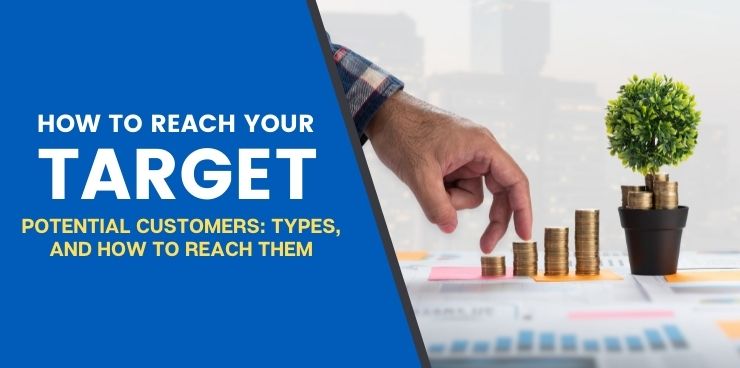While the ideal customer is a loyal customer, not everyone will evangelize your business’s virtues to their friends and family. Any customer that has an exemplary experience with your business can be a loyal customer, so it’s critical to foster that kind of environment.
Prospective customers, as well as existing customers, require attention and cultivation tailored to their needs and wants. This can take time, or it can happen in one transaction. Determining best practices for your business depends on the types of customers you need to appeal to the most.
In this article, we will explain the different types of customers. We will also address how to do your research and reach them appropriately according to their type.
What are the Different Types of Customers?
There are seven primary types of customers based on their behavior. Each requires a different approach to selling and customer service. The common thread between these customer types is that positive interactions will give them an incentive to purchase.
In order to know how to go about creating positive interactions, let’s look at each of the customer types:
1. Potential Customers
Potential customers are hesitant to buy but are susceptible to sales efforts. They often ask questions and respond best to good customer service. They are usually considering multiple options, so businesses should strive to stand out and pay them special attention.
2. New Customers
New customers are those that have recently made a purchase from your business. They respond best to customer service, including offers of guidance or further services. Offering warranties and putting in the work to establish a relationship with a new customer can convert them to loyal customers.
3. Need-based Customers
Need-based customers shop knowing what they want. They either leave with the item they were looking for or go somewhere else. This type of customer is likely to reject sales attempts and shopping assistance. They respond best to excellent service and personal interactions.
4. Discount Customers
Discount customers, also known as bargain hunters, only buy on sale. Whether or not they are able to pay full price, getting a lower price is important to them. They are difficult to keep as they will move on to whichever company has the best deal. They respond best to discount and value-added offers.
 5. Wandering Customers
5. Wandering Customers
Wandering customers are the type that shops for entertainment. They are often window shoppers and don’t make purchases after browsing. They may ask questions about products, but what counts to them is the interaction. A positive experience can convert them to potential or even new customers.
6. Impulsive Customers
Impulsive customers are most susceptible to sales techniques. They are prone to unplanned purchases and will follow recommendations. This type of customer is difficult to predict but often gravitates toward companies carrying a variety of products.
7. Loyal Customers
This type of customer will stand by a brand and promote it to others. Loyal customers are highly participatory and respond to praise and recognition from the company they follow.
7 Ways to Reach Your Potential Customers
Now that you know the seven types of potential customers, it’s time to look at how best to reach them. The first step is to do your research. You’ll have to do more than just ordering sales leads online.
Different types of customers have different behaviors that can make them easier or harder to reach. It’s impossible to predict exactly how potential customers will behave. But, with these seven methods, you will be able to develop a marketing strategy that works for your business:
1. Know Your Competitors
Whether you’re just entering a market or need to change up your current strategies, researching your competitors should be your first step. What are they doing, how are they doing it and is it working? Most importantly, ask yourself how you can improve on their strategies.
This is an inexpensive way to gain insight into your target market as well as your competition. Knowing your competitors will also help you plan how you can stand out. There may even be demographics your competitors are missing out on, giving you a leg up.
 2. Utilize Targeted Ads
2. Utilize Targeted Ads
Targeted advertising is big business these days. Not only is it often more effective than traditional advertising in some markets, it’s also cheaper.
The traditional advertising methods put out ads that are visible to anyone and everyone who happens to come across them. The big draw of targeted advertising is that advertising providers use user data to show ads to your target customers. Instead of paying for a broad strategy, business owners pay per interaction brought in.
Targeted ads are a bespoke advertising strategy that capitalizes on the increasing number of potential clients using ad-supported websites. The trick is, you need to know what demographics you want to target.
3. Leverage Your Social Media
Many businesses use their social media accounts only for the sake of having them. Not using this platform is a huge mistake for modern businesses. It’s more than free advertising space for your products and services, and more than a place to put your contact information.
One of the worst experiences existing customers can have is not being able to reach your business. Customers need to have easy access to the sales team and customer service. Social media is the ideal contact method for most customers because it’s not complicated.
The more complex the customer service process is for customers, the more it seems like you’re avoiding them. Staying active on social media makes a business appear approachable, up-to-date and engaged with their customer base.
4. Use Web Analytics
Web analytics are simply tools and measurements for online activity. To leverage your business’s social media successfully and get potential customers’ eyes on your content, you need web analytics.
Web analytics can help you plan your online marketing strategy but telling you what’s working and what isn’t, and why. Search engines also use web analytics in the algorithms that create the order in which results appear. If you aren’t producing engaging content consistently, your online presence can fizzle out.
If you don’t already, having a dedicated online marketing team is worth the extra expense. Having a team that understands web analytics can mean your website gets listed above your competitors, and that’s a win for you.
5. Promote with Affiliate Marketing
Similar to targeted advertising, affiliate marketing can help you build brand awareness online. When affiliates, usually influencers, mention and link to your business, it’s functionally the same as a recommendation for most consumers.
For a customer base that spends a lot of time online, seeing your business all over will cement it in their minds. Affiliate marketing also builds associations between your product or service and the pain points they solve.
Affiliate marketing can influence customers that research their decisions ahead of time. Those customer types can be hard to sell to and make up a large portion of consumers. That fact alone makes affiliate marketing worth it for most businesses.
6. Stand Out with User Reviews and Likes
Public, positive reactions from your customers can convert potential customers to loyal customers. Reading glowing reviews or seeing high averages over many ratings will prime new customers for a good first impression. There are two common ways companies can go about leveraging their positive reviews to establish trust:
First, many companies compensate customers for reviews. The easiest and most genuine way is to offer the product or service for free in exchange for a review. Many businesses also include a request for reviews alongside purchase receipts.
Second is to use the best reviews in promotional material. Featuring reviews from your existing clients on your website is an inexpensive way to simulate personal recommendations to prospective customers.
7. Keep Updated with Emails, Tweets, Messages and Calls
Finally, one of the most effective ways to reach your potential customers is to engage with them directly. As we mentioned previously, potential customers often ask questions before purchasing, and not answering leaves a negative impression. No matter what method consumers use to contact your business, it’s vital to answer promptly.
Spreading out the ways customers can reach you across several platforms ensures everyone can get in touch with your business. In doing so, your potential customer base can expand. You can also ease the load on your customer service team.
The availability of your business to potential customers can make or break your success with sales leads. If a qualified lead tries to contact you, a long wait or even no response will drive them away. Staying updated with a variety of contact channels is key to establishing and maintaining your relationship with customers.
It can be hard to balance finding and winning new customers with keeping existing clients. The first step to achieving that balance is to understand the types of potential customers and how to reach them. The next step is to develop a winning strategy or set of strategies.
At Selling Revolution, we’re more than a lead generation company. We focus on channel alignment to help you balance successful advertising, sales team and website. Book a call with us today and see the difference our solutions can make for your business.


 5. Wandering Customers
5. Wandering Customers 2. Utilize Targeted Ads
2. Utilize Targeted Ads